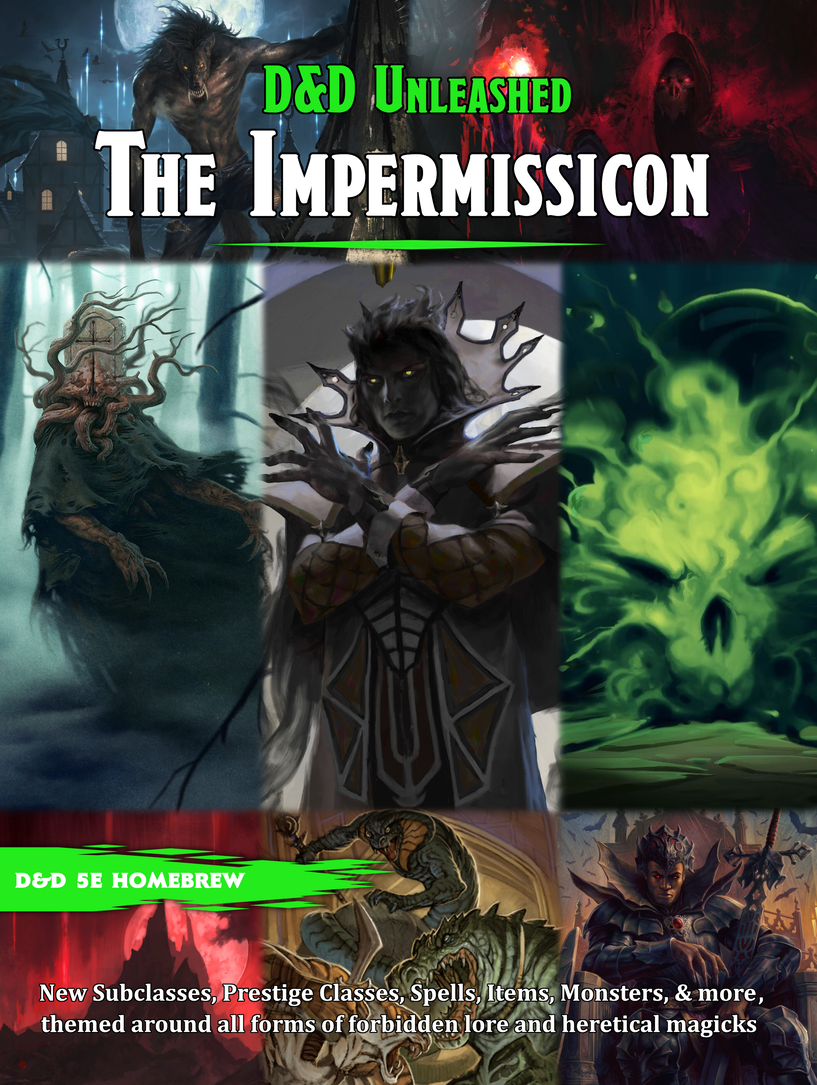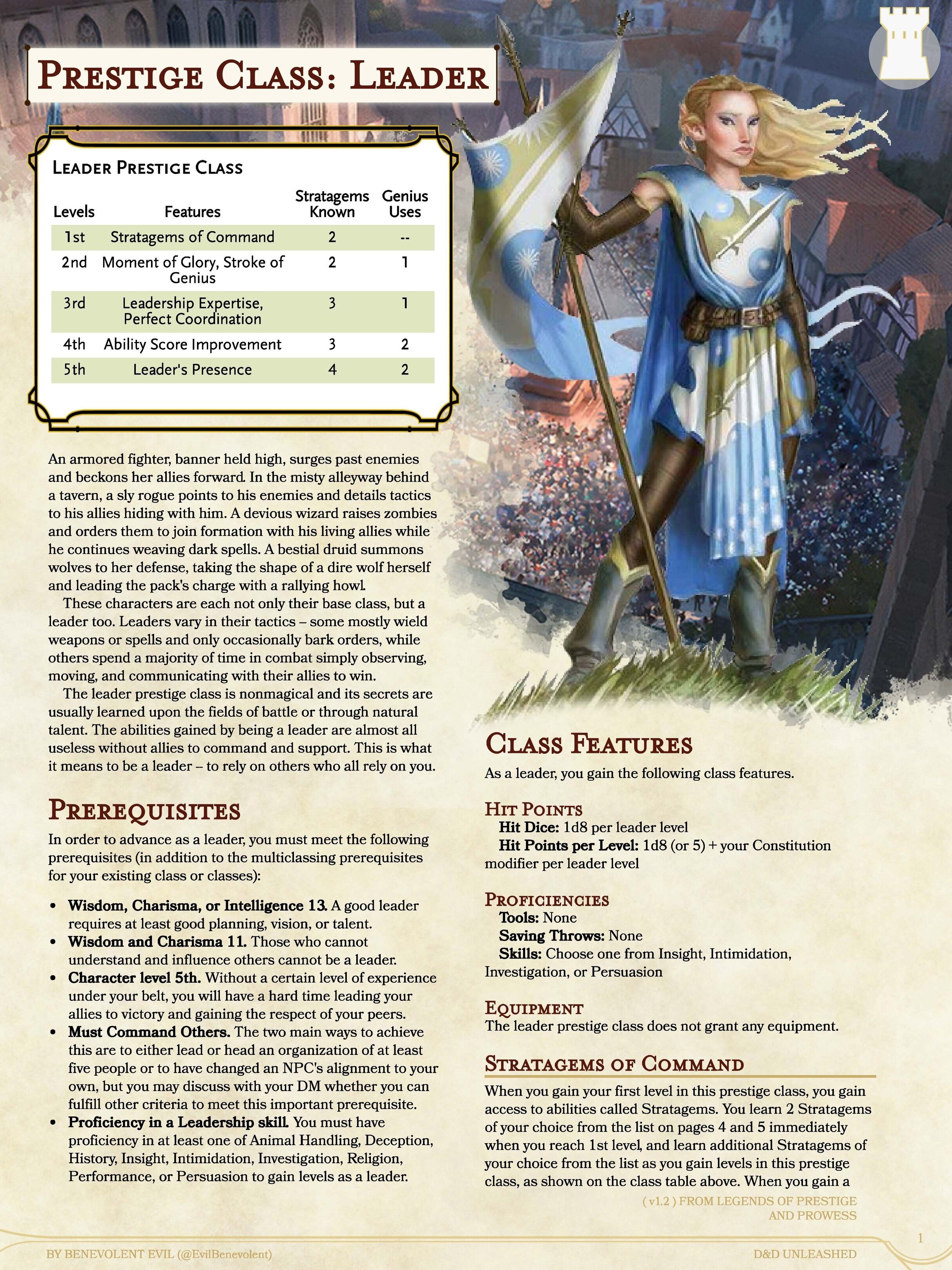The Juggernaut (Prestige Class)
The most updated version of this content can be found within The Impermissicon, a free 254-page compendium that you can download right here, filled with 24 subclasses, 3 prestige classes, 2 feats, 107 spells, 118 spell variants, 91 monsters, 61 magic items, 24 poisons, 23 diseases, and even more goodies themed around lycanthropes, vampires, and forbidden magic for both players and DMs!
“Everlasting Life. The most famous and popular kind of forbidden magic.”
Juggernaut PDF Link
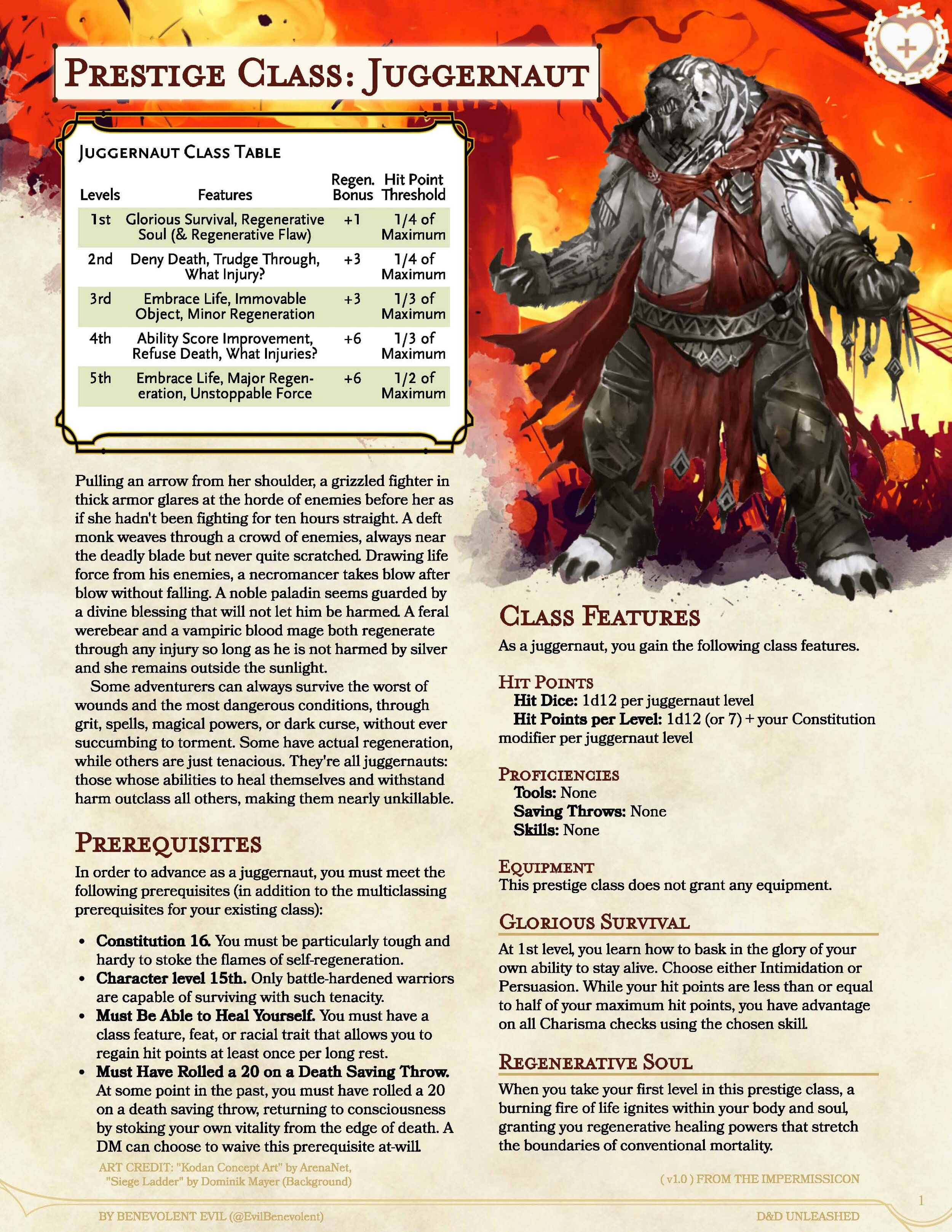
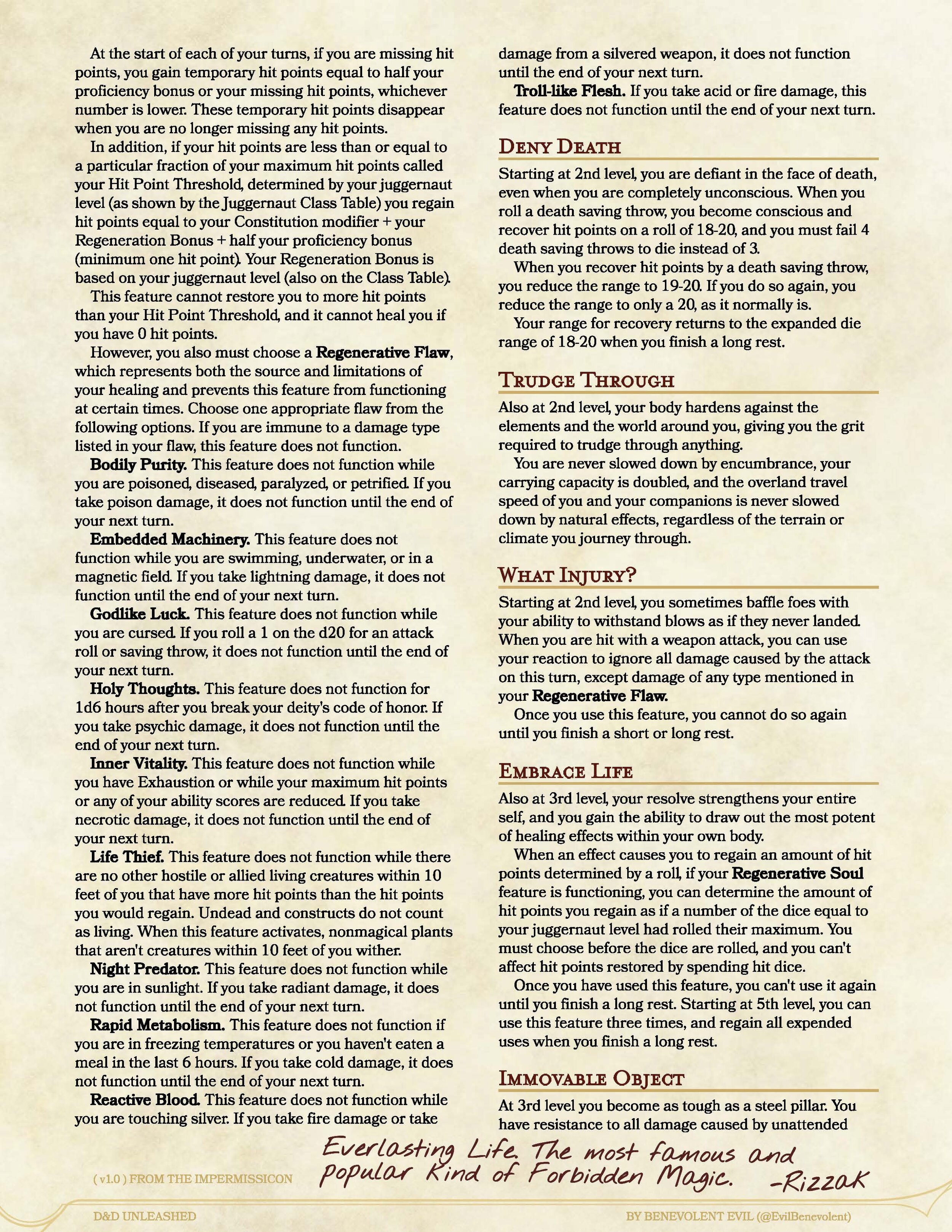
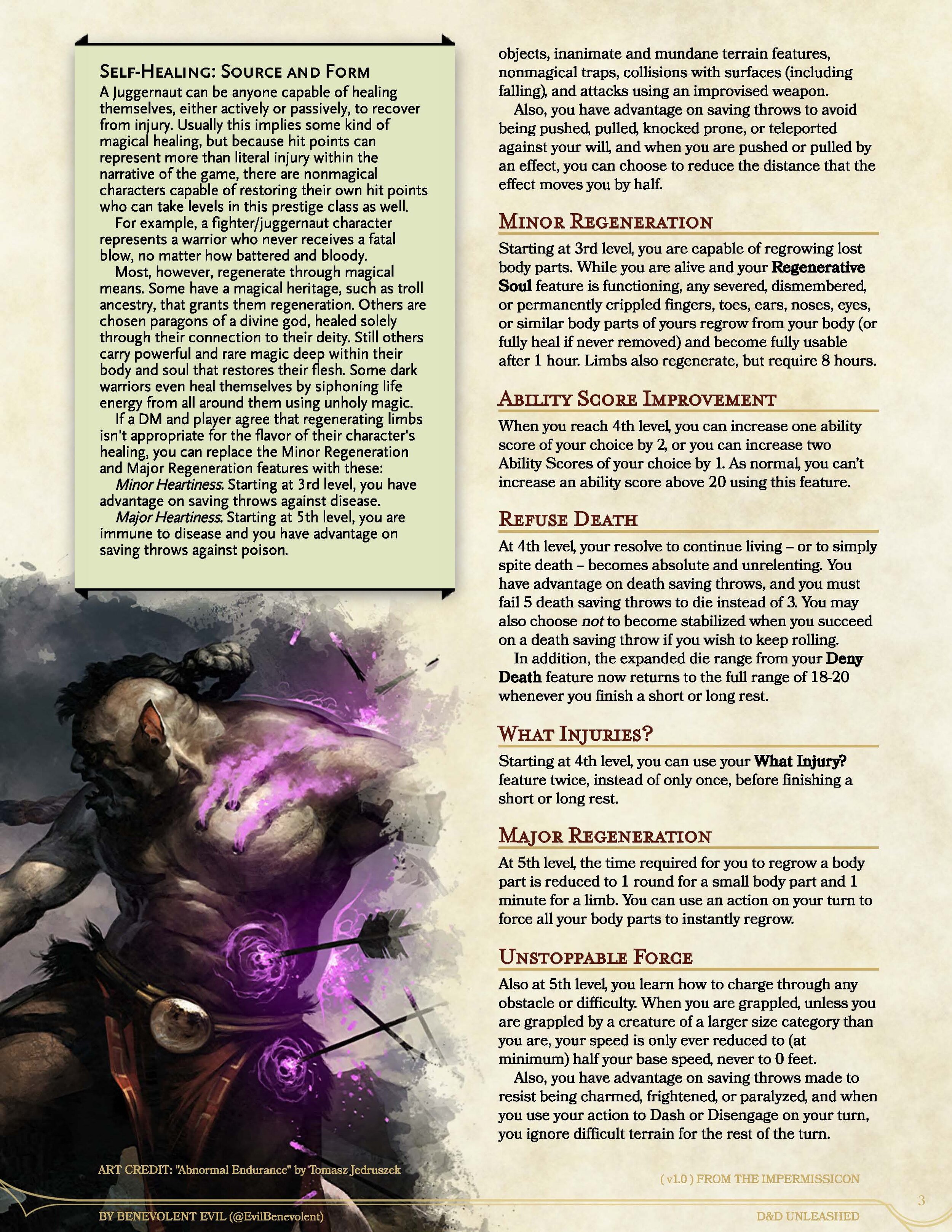
There are some concepts that just can’t quite be achieved using the normal 5th edition classes. If you want to build a truly regenerative warrior in Dungeons and Dragons, your options are normally limited to the Champion fighter subclass. But fantasy stories are rife with creatures and even heroes that can regenerate innately or fight with endurance that seems truly endless. For these concepts, D&D Unleashed presents the Juggernaut prestige class, available to high-level characters that can already heal themselves by some innate method. We are previewing it now, but it will also appear in the upcoming compendium of forbidden and dangerous magic, The Impermissicon, when it releases.
The design of the juggernaut might seem precarious, but it is very carefully engineered. The central feature of the prestige class is its regeneration, which provides potentially unlimited healing to the player character, but only within certain limited parameters and only at a limited rate. These drawbacks are important, as unlimited regeneration is extremely powerful in 5th edition D&D, since it begins to break some of the bounds of resource usage throughout the adventuring day. However, this design isn’t brand new. The Champion subclass for fighters has a similar unlimited healing ability as its capstone at level 18. Unlike that subclass, the Juggernaut’s regeneration takes many levels to reach its full speed and power. The Champion regains hit points up to half of its maximum hit points, whereas the Juggernaut’s first level only restores hit points up to one quarter of maximum hit points — when a character is perilously close to falling unconscious or even dying. Only upon reaching level 20 — and investing five levels into this prestige class — can a non-Champion character gain similar kinds of healing. In most games, which don’t typically go into epic levels, this requires the Juggernaut character to forego the capstone features of their class (and possibly subclass), which can be a costly trade for many player characters.
The Juggernaut’s regeneration also has another limitation that distinguishes it from the fighter subclass’s healing and allows the DM some choice in how powerful the Juggernaut’s healing is. Each Juggernaut chooses a particular Regenerative Flaw that represents the source of their healing and the weaknesses that can disable it. That means that the DM, in selecting the monsters and dangers that can befall the party, can control for the Juggernaut’s design to fit it into their own game and ensure that the Juggernaut does not eclipse other party members yet also feels that their Juggernaut levels were worthwhile. If the DM feels that the Juggernaut has become too invincible and it is hurting the fun for the other players, they can use more threats that target the PC’s regenerative flaw. If they feel that the Juggernaut is not having enough success and it is hurting the player’s fun, they can avoid triggering the flaw entirely. Remember that even when you are intending to limit the power of the Juggernaut, target the flaw judiciously and allow ways for the PC to evade the threat from time to time, or you may risk frustrating the player!
Of course, the Juggernaut has other features besides just its regeneration which help to cement its themes as a secondary class that can augment the definition of any character, changing any class into a juggernaut-ified version of that class. Even at first level, the Juggernaut gains a meaningful interaction ribbon in the Glorious Survival feature. When the juggernaut is visibly injured, they become either inspiring or terrifying. At 2nd-level, the juggernaut gains the Trudge Through feature, providing an exploration ribbon as well. Some aspects of the Immovable Object feature act as both an interaction and exploration ribbon, and then at 3rd and 5th-level, Minor Regeneration and Major Regeneration provide the Juggernaut with a unique ribbon-like ability to regrow their lost body parts.
The Juggernaut also has other features that provide mechanical bonuses for combat. Since the Juggernaut is likely to stay at low hit points to benefit from their regeneration, they gain the Deny Death and Refuse Death features to help them survive if they do fall all the way to zero, which will happen often. They also gain the feature named “What Injury?” that allows them to negate the damage from a few weapon attacks per day, giving them a constant choice when taking damage: “should I use my reaction to negate this large attack now? Or should I wait for when I am critically hit?” At 3rd-level and again at 5th-level, the Juggernaut gains uses of the Embrace Life feature, which was designed to help the Juggernaut avoid conflict with other healing characters in a party. In other words, without this feature, the Juggernaut’s single-minded focus on self-healing made other healing party members feel less helpful, and made the Juggernaut itself feel less useful to the players leveling it. Finally, the Immovable Object and Unstoppable Force features both aid the Juggernaut in combat directly by helping them to charge through any obstacle and avoid being moved or controlled against their will.
For some examples of the different kinds of characters you can build by multiclassing into the Juggernaut prestige class, we have the following list of 20th-level and higher characters:
The Blood Font: Sorcerer 18 (Blood Magic) / Juggernaut 2 — When the Blood Magic sorcerer was originally previewed, it had a 18th-level feature that caused enemies to explode. While fun, this ability didn’t fit the theme of the subclass, and it was moved to a different player option in the compendium. The new 18th-level feature for the blood sorcerer grants them intense regeneration while below half hit points, as they become an endless font of magically-charged blood. By taking two levels in Juggernaut as well, this character becomes even more focused on staying at low hit points, constantly healing at obscene rates and fueling spells by expending hit points at the cost of having perilously few hit points at any given time and thus being dangerously close to going down! Their chosen flaw is Bodily Purity, since Inner Vitality would be triggered by Hematurgy, and because they have advantage on saving throws against poison.
The Chosen One: Cleric 17 (Blood or Life) / Juggernaut 3 — This cleric is the anointed chosen one of a god of life, healing, or martyrs, and so they are prevented from reaching death as if watched over by a guardian angel at all times and encouraged to risk their lives for the sake of others. They have access to 9th-level spells and their domain’s 17th-level capstone feature, but also reach the 1/3rd threshold for Juggernaut. Their chosen flaw is, of course, Holy Thoughts. Their cleric proficiency in Wisdom and Charisma saving throws should help them avoid any psychic damage.
The Death Knight: Paladin 15 (Oath of Decay) / Juggernaut 5 — The Oath of Decay is a new paladin subclass appearing in The Impermissicon with the goal of allowing PCs to be built as fully-themed death knights, as opposed to the more generic “Oath of Villainy”-style themes of the Oathbreaker subclass from the Dungeon Master’s Guide. This juggernaut multiclass transitions from death-knight-like paladin to full death knight by becoming truly undying! Their chosen flaw is Life Thief, which might be one reason why they continue to adventure among living party members!
The Great Sensei: Monk 14 (Open Palm) / Leader 5 / Juggernaut 1 — This character reaches the potent 14th-level monk feature (which grants proficiency with all saving throws) and also reaches the capstone Presence feature from 5 Leader levels. They focus on the reaction that grants temporary hit points to allies when the Great Sensei takes a lot of damage, constantly tanking hits to protect their allies and healing automatically if they get too low — an inspiring teacher that doesn’t break in the face of adversity. Their chosen flaw is Inner Vitality, since Bodily Purity combined with their immunity to poison and disease would render their regeneration permanently disabled.
The Relentless Defender: Fighter 11 (Deathless) / Guardian 5 / Juggernaut 4 — This character is nothing more than an unyielding and inexhaustible warrior. They make it to the second Extra Attack in the fighter class, selecting a fighter subclass that enhances their survivability, then take 5 levels in guardian for the reaction-returning capstone feature before finally taking levels in Juggernaut up to level 20. Along the way, this PC takes the Sentinel feat, making them nearly impossible for even a horde of enemies to run past. This character resembles a level 20 Champion fighter in some ways, like their regeneration, but they trade their fourth attack each turn, extra uses of features like indomitable, and their 15th and 18th-level subclass features for their regeneration, mark, additional hit points, and powerful opportunity attacks. While they could choose Bodily Purity or Inner Vitality to synergize with their defensive Deathless features, their chosen flaw is instead Rapid Metabolism, because the player feels it fits their theme better.
The Steelheart: Artificer 15 (Battle Smith) / Juggernaut 5 — The Steelheart is an artificer that has surgically embedded magical machinery into their body to keep them alive through any injury. They reach their last subclass feature and then take all five levels in juggernaut to build a powerhouse of melee combat. The Steel Defender’s reaction combines with martial weapons, battle-focused spells, and extreme regeneration to turn the artificer into a powerful and versatile defender that can fluidly swap between taking the enemy attacks themselves or directing enemy attacks to their construct. Their chosen flaw is, of course, Embedded Machinery.
The Vampire: Warlock 15 (The Progenitor) / Juggernaut 5 — This character is designed to emulate all the traits and abilities of a normal vampire, including regeneration, rather than to be powerful in a particular way (though it may still be powerful). The warlock spell slots are largely used for traditional vampiric abilities, such as summoning bats and wolves, charming enemies, and draining blood. They select all the invocations available to the Progenitor warlock that give them vampiric abilities, including a limited form of regeneration, and then take their last five levels in Juggernaut to gain extreme, constant regeneration. Since they are intended to be a vampire, their chosen flaw is obviously Night Predator, giving them weakness to the sunlight.
The Werewolf: Barbarian 15 (Were-Beast) / Juggernaut 5 — This character is designed to emulate all the traits and abilities of a powerful werewolf with regeneration, such as a loup-garou. They reach the powerful 14th-level feature for the Were-Beast barbarian subclass, then unlock Persistent Rage at 15th-level. Their last five levels go into the Juggernaut prestige class for maximum regeneration and toughness, losing out on the potent barbarian capstone and unlimited rages at level 20 in return. Because it grants them the weakness to silvered weapons that they desire for their werewolf theming, their chosen regenerative flaw is Reactive Blood.
(Epic Tier) The Wolverine: Barbarian 20 (Beast) / Juggernaut 5 — This 25th-level character is made to resemble the classic Wolverine of X-Men fame. The Beast subclass for barbarians (from Tasha’s Cauldron of Everything) provides the PC with the claw weapons that match Wolverine, and the bite attack’s healing meets the prerequisites for the juggernaut. With 20 barbarian levels, this wolverine can rage endlessly and thus unleash their claws at any time, and they increase their Strength and Constitution up to 24, granting them an absurd amount of toughness when combined with the Juggernaut’s regeneration. For their regenerative flaw, this PC could choose Embedded Machinery (to match Wolverine’s weakness to magnetism), Reactive Blood (if they are leaning into lycanthropy themes), or even Troll-like Flesh (if they want to build their own theme).
(Epic Tier) The Mighty Mammoth: Druid 20 (Moon) / Barbarian 7 (Totem Warrior) / Juggernaut 3 — This 30th-level character is built to maximize survivability while retaining access to 9th-level and lower druid spells. This druid can use its wild shape an unlimited number of times to transform into a powerful CR 6 mammoth, casting druid spells through the transformation the entire time. When they don’t need to cast spells, they can enter their barbarian rage to gain resistance to all damage. Their regeneration functions both in and out of wild shape, meaning the druid can withstand hundreds of hit points worth of damage every turn! And that doesn’t even consider the healing and buffs (such as foresight) that the druid can constantly apply to themselves between battles. Their chosen flaw is Troll-like Flesh.




